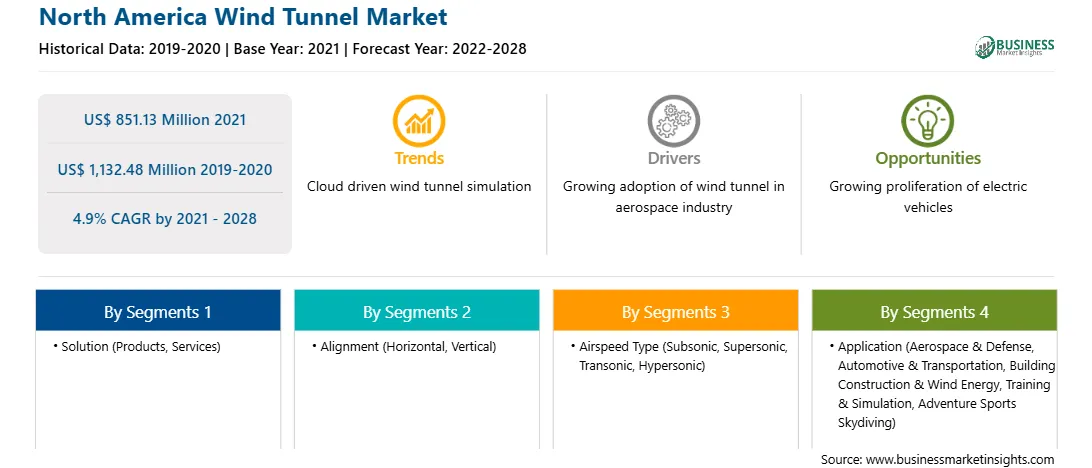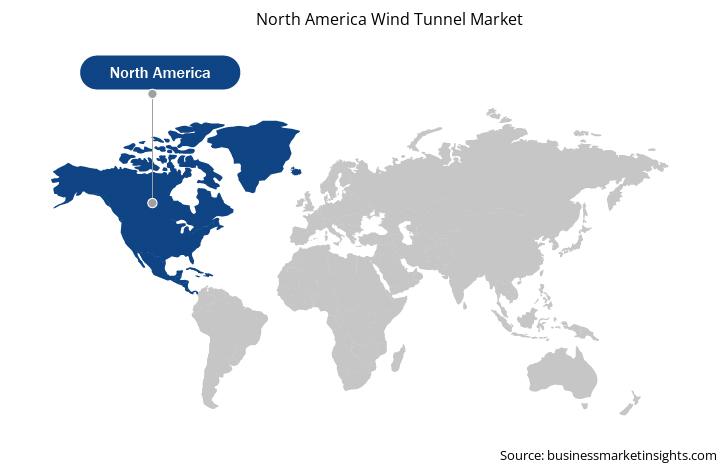The US, Canada, and Mexico are major economies in North America. Wind tunnels simulate air movement around an in-flight aircraft. They are widely used in the aerospace industry as they allow aeronautical engineers to control the conditions affecting the forces and motion of the plane. The engineer can determine and analyze the magnitude of forces on a real full-size aircraft by recreating it on a scaled-down aircraft model. Furthermore, the wind tunnel-based model can also be applied for testing and diagnostics to carry out a comprehensive analysis of the aerodynamics of the aircraft body by determining the air movement around or through the aircraft. Wind tunnels were primarily used to observe and determine the fundamental working of new aircraft designs, but the dominance of tube and wing design in the market has led to extensive use in the verification and certification processes. The dynamic nature of aeronautic research and more efficient integration with computational fluid dynamics (CFD) software contributes to the widespread use of wind tunnels.
The specifications of aircraft model testing have become highly stringent, leading to an increase in the use of wind tunnels made of carbon-epoxy and other composite materials. These tunnels are fabricated using masters prepared through numerically controlled machining. These lightweight models exhibit dimensional accuracy, long-term stability, and hollowness; thus, a comprehensive instrumentation range can be carried. These advancements in wind tunnels ensure that the effects of aerodynamic interference between the models and their support and instrumentation systems are significantly reduced during wind tunnel testing. The tunnels are designed for specific purposes and are often integrated with sensors and components to generate precise test results. For instance, PCB offers a complete line of dynamic pressure sensors, microphones, and force sensors for wind tunnels. These components for wind tunnels are categorized based on the speed of the wind.
During 2020–2021, the aerospace industry witnessed a dramatic fall in aircraft production due to the COVID-19 pandemic. Major aircraft manufacturers experienced a gradual rise in demand with the resumption of air travel after the successful implementation and scale-up of vaccination programs. These developments triggered the production performances of prominent aircraft manufacturers, such as Boeing and Airbus. In 2021, Boeing delivered over 340 jetliners to airlines and other buyers, up from 157 in 2020. Further, Airbus delivered 611 passenger jets in 2021, with an 8% rise over the deliveries in 2020. Therefore, the gradually growing aerospace industry and the widespread use of wind tunnels in aircraft production are bolstering the market growth.
With the new features and technologies, vendors attract new customers and expand their footprints in emerging markets. This factor is driving the growth of North America Wind tunnel market and is expected to grow at a significant CAGR during the forecast period.
The North America wind tunnel market is analyzed on the basis of solution, alignment, airspeed type, application, and country. Based on the solution, the wind tunnel market is bifurcated into services and products. The services segment is expected to continue its dominance during the forecast period. Wind tunnels' reduced operation & maintenance (O&M) costs and the easy availability of technical installation and maintenance drive the segment's growth. Based on alignment type, the wind tunnel market is bifurcated into horizontal and vertical segments. The horizontal segment accounted for a larger market share in 2020 and is expected to continue its dominance. Based on airspeed type, the market is segmented into subsonic, supersonic, transonic, and hypersonic. The subsonic segment held the largest market share in 2020. The rising demand for commercial aircraft and automotive testing services is the primary factor responsible for the growth of this segment. Based on application, the market is segmented into aerospace and defense, automotive and transportation, building construction and wind energy, training and simulation, adventure sports skydiving, and others. Aerospace and defense segment held the largest market share in 2020 and is expected to continue its dominance during the forecast period. The increased usage of wind tunnels for testing aircraft used for aerospace and defense applications is a major factor responsible for the segment's growth. Based on country, the market is segmented into the US, Canada, and Mexico. Furthermore, Aerolab; Aiolos; Boeing; ETW GmbH; Horiba Ltd; Lockheed Martin Corporation; Mahle GmbH; Mitsubishi Heavy Industries, Ltd; Rail Tec Arsenal; and RUAG are among the leading companies in the North America wind tunnel market.
Strategic insights for the North America Wind Tunnel provides data-driven analysis of the industry landscape, including current trends, key players, and regional nuances. These insights offer actionable recommendations, enabling readers to differentiate themselves from competitors by identifying untapped segments or developing unique value propositions. Leveraging data analytics, these insights help industry players anticipate the market shifts, whether investors, manufacturers, or other stakeholders. A future-oriented perspective is essential, helping stakeholders anticipate market shifts and position themselves for long-term success in this dynamic region. Ultimately, effective strategic insights empower readers to make informed decisions that drive profitability and achieve their business objectives within the market.

| Report Attribute | Details |
|---|---|
| Market size in 2021 | US$ 851.13 Million |
| Market Size by 2028 | US$ 1,132.48 Million |
| Global CAGR (2021 - 2028) | 4.9% |
| Historical Data | 2019-2020 |
| Forecast period | 2022-2028 |
| Segments Covered |
By Solution
|
| Regions and Countries Covered | North America
|
| Market leaders and key company profiles |
The geographic scope of the North America Wind Tunnel refers to the specific areas in which a business operates and competes. Understanding local distinctions, such as diverse consumer preferences (e.g., demand for specific plug types or battery backup durations), varying economic conditions, and regulatory environments, is crucial for tailoring strategies to specific markets. Businesses can expand their reach by identifying underserved areas or adapting their offerings to meet local demands. A clear market focus allows for more effective resource allocation, targeted marketing campaigns, and better positioning against local competitors, ultimately driving growth in those targeted areas.

The North America Wind Tunnel Market is valued at US$ 851.13 Million in 2021, it is projected to reach US$ 1,132.48 Million by 2028.
As per our report North America Wind Tunnel Market, the market size is valued at US$ 851.13 Million in 2021, projecting it to reach US$ 1,132.48 Million by 2028. This translates to a CAGR of approximately 4.9% during the forecast period.
The North America Wind Tunnel Market report typically cover these key segments-
The historic period, base year, and forecast period can vary slightly depending on the specific market research report. However, for the North America Wind Tunnel Market report:
The North America Wind Tunnel Market is populated by several key players, each contributing to its growth and innovation. Some of the major players include:
The North America Wind Tunnel Market report is valuable for diverse stakeholders, including:
Essentially, anyone involved in or considering involvement in the North America Wind Tunnel Market value chain can benefit from the information contained in a comprehensive market report.